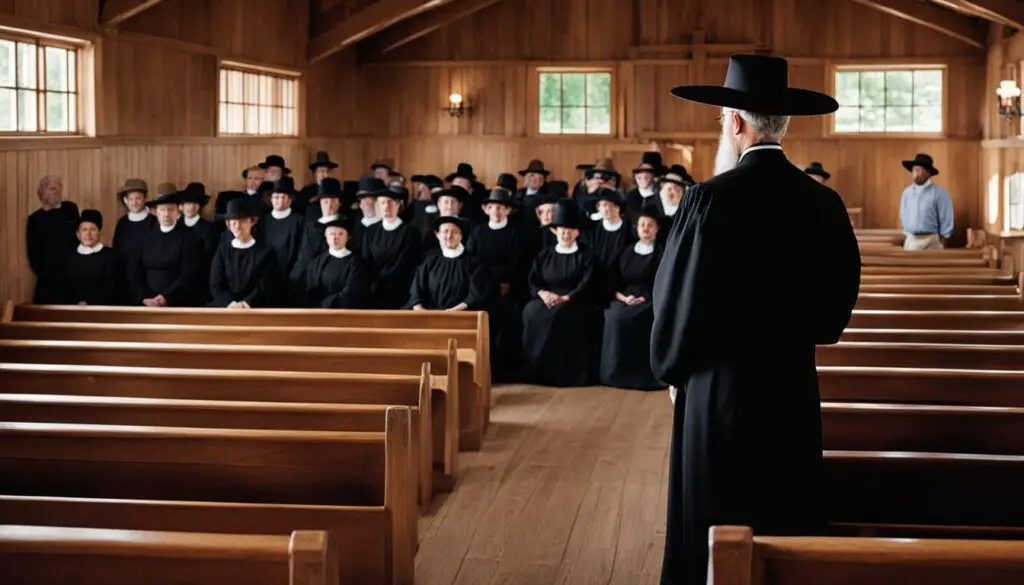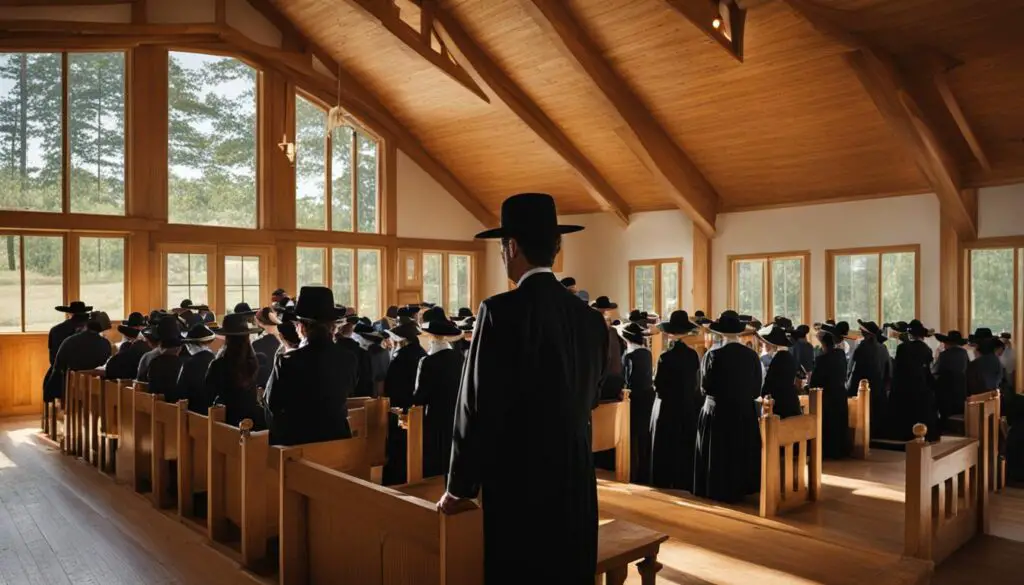Welcome to the captivating world of the Amish church, a community steeped in rich history and unwavering faith. Let us embark on a journey through time, exploring the origins, beliefs, rituals, and challenges of this remarkable group.
The Amish church traces its roots back to a 1693 schism in Switzerland led by Jakob Ammann. Seeking religious freedom, Amish communities migrated to North America in the 18th century, with Lancaster County, Pennsylvania, becoming home to the oldest and largest Amish community in the United States.
Central to the Amish way of life are their deeply held beliefs and doctrines. Embracing principles such as nonresistance, nonconformity to the world, and the separation of church and state, the Amish prioritize humility, simplicity, and submission to God’s will.
Amish church membership begins with adult baptism, usually between the ages of 16 and 23, and is accompanied by sacraments like the Lovefeast, foot washing, and the Holy Kiss. Worship services are held every other Sunday in members’ homes or barns, fostering a strong sense of community and kinship.
The Amish church operates under a decentralized structure, with each church district led by a bishop, supported by preachers and an elder. Governed by the Bible and the Ordnung, a set of unwritten rules, these autonomous districts make decisions that align with a literal interpretation of their sacred texts.
Amish worship practices reflect their devotion and distinct cultural identity. Services are conducted in High German, while Pennsylvania Dutch, a variant of the German language, is spoken at home. The absence of traditional church buildings adds to their unique appeal, as worship gatherings take place in family homes or barns.
Key Takeaways:
- The Amish church originated from a 1693 schism in Switzerland and migrated to North America in the 18th century.
- Amish beliefs prioritize nonresistance, simplicity, and submission to God’s will.
- Adult baptism and sacraments like the Lovefeast and foot washing are integral to Amish church rituals.
- Church districts are led by bishops, assisted by preachers and elders, making decisions based on biblical teachings and the Ordnung.
- Amish worship services are conducted in High German, with a strong sense of community and a focus on family relationships.
Origins and Background
The Amish church has its origins in the Mennonite community and traces its roots back to the Anabaptist movement during the Reformation in Europe. The Amish tradition of farming and worshiping in homes instead of separate church buildings began in Switzerland and southern Germany.
“The Amish church originated from the Mennonites, who themselves were influenced by the Anabaptist religious movement.” – Professor James B. (Amish Historian)
The Anabaptist movement, which emerged in the 16th century, emphasized adult baptism and separation from the state-controlled churches. The Amish, led by Jakob Ammann, formed their own distinct church in Switzerland in 1693 due to disagreements over church discipline and the use of technology.
Driven by a desire to maintain their religious principles and preserve their way of life, Amish communities migrated to North America in the 18th century. They sought religious freedom and respite from persecution in Europe. The largest and oldest Amish settlement in the United States is in Lancaster County, Pennsylvania.
Amish Origins Timeline
| Year | Event |
|---|---|
| 1693 | The Amish church is officially founded in Switzerland. |
| 18th Century | Amish communities migrate to North America, primarily Pennsylvania. |
| Present Day | Amish communities continue to thrive and maintain their distinct way of life. |
Beliefs and Doctrines
The Amish embrace a set of core beliefs and doctrines that shape their way of life and define their faith. These beliefs are deeply rooted in their commitment to biblical teachings and a desire to live in accordance with God’s will.
Nonresistance and Nonconformity to the World
A central tenet of Amish beliefs is the principle of nonresistance. They firmly believe in following Jesus’ teachings on peace and love, and therefore reject violence and participation in war. The Amish strive to live separate from the world and its values, maintaining a distinct identity and resisting the temptations of modern society.
Separation of Church and State
The Amish firmly believe in the separation of church and state. They prioritize their allegiance to God and the church over any earthly government. The Amish avoid involvement in politics and the military, choosing instead to live under their own system of governance within their tightly-knit communities.
The Priesthood of All Believers
The Amish place a strong emphasis on the priesthood of all believers, believing that every individual has a direct and personal relationship with God. They reject the hierarchical structure found in many other Christian denominations and encourage active participation and service from every member of the community.
Humility and Simplicity
Humility and simplicity are cherished virtues within the Amish faith. The Amish strive to live modest and unpretentious lives, avoiding materialism and worldly pursuits. They value simplicity in clothing, home furnishings, and overall lifestyle, focusing instead on spiritual growth, family, and community.
Gelassenheit: Submission to God’s Will
Gelassenheit, meaning a surrender to God’s will, represents a fundamental aspect of Amish faith. It encompasses a willingness to submit to God’s plan and to accept life’s challenges with patience and humility. Through Gelassenheit, the Amish find strength and contentment in living in harmony with God’s purposes.
“The Amish faith is built on a foundation of steadfast beliefs rooted in the teachings of Jesus Christ. Nonresistance, nonconformity, separation of church and state, the priesthood of all believers, humility, simplicity, and Gelassenheit form the bedrock of the Amish way of life. These beliefs shape their every aspect of life, from their interactions with the world to their relationships within the close-knit Amish community.” – Amish Community Leader

The Amish beliefs and doctrines are the guiding principles that govern their daily lives. These principles, rooted in a deep faith, help the Amish navigate the complexities of the modern world while remaining steadfast in their commitment to their values and traditions.
Sacraments and Rituals
The Amish church, with its deep-rooted beliefs and traditions, practices various sacraments and rituals that hold great significance in their community. These sacred practices serve as pillars of their faith, reinforcing their commitment to God and each other. Let’s explore some of the key sacraments and rituals observed by the Amish.
Adult Baptism:
One of the foundational sacraments in the Amish church is adult baptism. Typically, individuals undergo baptism between the ages of 16 and 23, symbolizing their conscious decision to follow Jesus Christ and embrace the Amish way of life. Adult baptism signifies spiritual rebirth and entry into the Amish community, where members are devoted to living a simple and humble existence.
The Lovefeast:
The Lovefeast is a cherished communal gathering of Amish church members. This ritual involves sharing a meal together, often consisting of simple, homemade foods. The Lovefeast fosters unity, gratitude, and fellowship within the Amish community, emphasizing the importance of selflessness and mutual support.
Foot Washing:
Foot washing is a solemn ritual that reflects Jesus’ act of humility when he washed the feet of his disciples. In the Amish church, foot washing symbolizes servanthood, humility, and forgiveness. Members take turns washing each other’s feet, demonstrating their commitment to love and care for one another in a spirit of equality.
The Holy Kiss:
The Holy Kiss is an expression of love and unity among Amish church members. This ritual involves a brief embrace or a touch on the cheek while exchanging greetings with fellow believers. The Holy Kiss serves as a reminder to show genuine affection and to foster a sense of belonging within the Amish community.
Worship Services:
Amish worship services are held every other Sunday in the homes or barns of community members. These gatherings are led by ministers, who deliver sermons in High German, a language that holds cultural and historical significance for the Amish. Worship services offer an opportunity for prayer, singing of hymns, and the study of scripture, reinforcing the spiritual bond among church members.
The sacraments and rituals practiced by the Amish exemplify their commitment to a humble, communal, and spiritually grounded way of life. These practices not only strengthen their relationship with God but also nurture a deep sense of togetherness within the Amish community.

Leadership and Clergy
Within the Amish church, the responsibility of guiding the community falls upon a dedicated leadership team. At the helm of each Amish church district is the bishop, who holds a position of authority and serves as a spiritual leader. Assisting the bishop are preachers and an elder, collectively forming a clergy that ensures the smooth functioning of the church.
The Amish value the autonomy of each church district, allowing them to make decisions that align with their specific congregation. This autonomy is grounded in a literal interpretation of the Bible, which serves as the guiding principle for Amish leadership. Additionally, the Ordnung, a set of unwritten rules passed down through generations, shapes the decision-making process and helps maintain the order and traditions within the community.
The bishop, preachers, and elder play vital roles in both spiritual and practical matters. They provide guidance, offer pastoral care, mediate disputes, and coordinate various activities within the church district. Their leadership ensures that the Amish community remains rooted in their faith and adheres to the principles of simplicity, humility, and submission to God’s will.

| Position | Responsibilities |
|---|---|
| Bishop | Spiritual leader, decision-maker, mediator |
| Preacher | Assists the bishop, delivers sermons and teachings |
| Elder | Assists the bishop, provides spiritual guidance, supports the community |
Worship Practices
The Amish community places great importance on worship practices, which are deeply rooted in their faith and traditions. These practices reflect their commitment to simplicity, community, and spiritual growth.

Gatherings in Family Homes and Barns
Amish worship services are held in family homes or barns on a rotating basis. This practice fosters a sense of intimacy and strengthens family and community bonds. It allows for a more personal and informal atmosphere, where worshipers can engage in prayer, song, and reflection together.
Language and Cultural Significance
During these worship services, the Amish use High German as their primary language. This choice reflects their desire to maintain their cultural heritage and sets their worship apart from the English language used in their daily lives. At home, they speak Pennsylvania Dutch, a dialect derived from the German language.
Community Spirit and Relationships
The Amish church groups have a strong sense of community, and worship serves as a driving force in connecting individuals with one another. Church members often support one another in times of difficulty and celebrate joys together. These worship practices reinforce the values of compassion, unity, and shared responsibility.
Deepening One’s Relationship with God
Amish worship practices provide an opportunity for individuals to deepen their relationship with God. Through prayer, worshipers seek guidance, express gratitude, and find solace in their faith. The focus on humility and devotion helps believers connect with their spiritual journey and reinforce their commitment to living a righteous life.
“Through our worship practices, we cultivate a sense of reverence, gratitude, and reflection. It is where we come together as a community, nurturing our relationships and deepening our connection with God and one another.” – John Hostetler, Amish elder
Passing on Traditions
Amish worship practices play a crucial role in passing on traditions to the younger generation. Children observe and participate in these worship services, learning the rituals, songs, and prayers that have been passed down for centuries. This immersive experience ensures the preservation of Amish practices and beliefs for generations to come.
| Key Aspects of Amish Worship Practices | Significance |
|---|---|
| Informal worship settings in family homes or barns | Promotes intimacy, community bonding, and a sense of belonging |
| Use of High German during worship services | Preservation of cultural heritage and distinction from everyday English language |
| Emphasis on prayer, song, and reflection | Avenues for deepening one’s spiritual journey and connection with God |
| Passing on traditions to younger generations | Ensures the preservation of Amish practices and beliefs |
Sacred Texts
The Amish church places a great emphasis on the teachings of the Bible, considering it to be their sacred text. The teachings and principles laid out in the Bible guide their way of life, shaping their beliefs, practices, and values. It serves as the foundation of their faith and provides them with moral guidance and spiritual inspiration.
In addition to the Bible, the Amish may also refer to other Anabaptist texts such as the Martyrs Mirror. Published in 1660, the Martyrs Mirror chronicles the history of the Anabaptist movement, including the experiences of Amish forefathers who faced persecution and martyrdom for their religious convictions. This influential text serves as a testament to the courage and resilience of those who sacrificed their lives for their faith.
“The Bible is our sacred text, and it is from its teachings that we draw strength, wisdom, and guidance in our daily lives. The Martyrs Mirror, with its stories of our ancestors’ faith and sacrifice, is a constant reminder of the price that has been paid for our religious freedom.”
– Eli Miller, Amish Elder
The Amish believe that studying and living by the teachings of these sacred texts allows them to cultivate a deep spiritual connection with God and reinforces their commitment to their communal way of life. They find comfort, inspiration, and guidance in the stories, teachings, and principles presented in these texts, shaping their beliefs and forming the fabric of their close-knit communities.
The Bible in Amish Life
The Amish view the Bible as the ultimate authority in matters of faith and practice. They believe in the infallibility of scripture and approach its teachings with reverence, seeking to apply its principles to every aspect of their lives. The Bible provides them with guidelines on issues such as nonresistance, simplicity, forgiveness, and love for one another.
Amish worship services typically center around the reading and interpretation of biblical passages. The congregation listens attentively as the bishop or a designated preacher expounds on the meaning of the scripture, offering insights and practical applications for daily life. This deep engagement with the sacred text fosters a sense of unity and communal understanding among the Amish.
The Martyrs Mirror: A Testament of Faith
The Martyrs Mirror holds a special place in the hearts of the Amish. It not only recounts the stories of early Anabaptist martyrs, including Amish ancestors, but also serves as a source of inspiration and encouragement in times of persecution and hardship. Through its pages, the Amish find solace in the faith and resilience of those who came before them, reaffirming their commitment to their beliefs.
Reading the Martyrs Mirror is not only a historical exercise for the Amish but an opportunity for reflection and spiritual growth. It reminds them of the sacrifices made for the sake of their faith and serves as a reminder to remain faithful in the face of adversity. The text helps strengthen their identity as a distinct religious community and reinforces the importance of preserving their traditions and beliefs.

Denominations and Sects
While the Amish church is the main denomination, there are various subgroups and sects within the Amish community. These include the New Order Amish, Old Order Mennonites, Conservative Amish Mennonite Conference, and others. Each group may have its own practices and beliefs.
- New Order Amish
- Old Order Mennonites
- Conservative Amish Mennonite Conference
- And others
Amish Sects:
- Swartzentruber Amish
- Andy Weaver Amish
- Beachy Amish
- And others
These denominations and sects can have variations in their lifestyle and religious practices while maintaining the core principles of the Amish faith. The different groups may differ in their approach to technology, dress, and interactions with the non-Amish world. Despite these differences, they all share a commitment to a devout and separate way of life.
Community and Outreach
The Amish church places a strong emphasis on community and family relationships within their close-knit Amish community. They strive to maintain a degree of separation from the non-Amish world, often referred to as “English”. One way they achieve this is through their own one-room schools, where Amish children receive a traditional education that aligns with their values and beliefs.
The Amish value the importance of supporting and caring for one another. They believe in the power of collective effort and working together as a community. As a result, they foster a sense of unity and harmony that extends beyond their immediate families. Helping one another through shared labor, known as “barn raising,” is a common practice among the Amish.
In addition to focusing on their internal community, the Amish also engage in outreach efforts to spread their faith. While their lifestyle may seem plain and simplistic to outsiders, they believe their faith and dedication to God can inspire others. Through acts of kindness and humility, the Amish aim to be a shining example of their beliefs and attract others to their way of life.
“We believe that by living our lives according to our beliefs, we can lead others to God’s path of righteousness and simplicity.” – Amish Elder
Amish Outreach Efforts
- Public talks and presentations
- Hosting community events and gatherings for non-Amish individuals
- Offering assistance during times of crisis or need
- Engaging in charitable acts and volunteering in local communities
Benefits of Amish Community Life
Living within the Amish community provides individuals with a sense of belonging and support. The close bonds among community members offer a network of people to rely on during challenging times. The Amish community not only serves as a religious entity but also as a social and emotional support system.
| Benefits of Amish Community Life | |
|---|---|
| Strong sense of belonging and support | Opportunities for collective effort and cooperation |
| Shared values and beliefs | Emphasis on strong family relationships |
| Guidance and wisdom from experienced community members | Protection from outside influences that may conflict with Amish beliefs |
The Amish community continues to thrive through their commitment to community, family, and outreach efforts. Their dedication to their faith and their desire to share their beliefs with others exemplify the values that define the Amish way of life.
Architectural and Artistic Features
Amish churches have a distinct approach when it comes to their architectural and artistic features. Unlike traditional church buildings, Amish worship services are held in homes and barns, reflecting their commitment to simplicity and community.
“Simplicity is the ultimate sophistication.” – Leonardo da Vinci
Amish architecture embodies the principles of practicality and functionality. Buildings are designed to serve a purpose rather than showcase elaborate designs. The emphasis is on creating spaces that fulfill the needs of the community without unnecessary extravagance.
While Amish architecture may lack ornate details, it possesses a timeless beauty that stems from its simplicity. The clean lines, sturdy structures, and efficient use of space create an aesthetic that is both pleasing to the eye and deeply rooted in the Amish way of life.
Traditional Amish Quilting and Woodworking
Within the realm of Amish artistic features, two notable crafts stand out: quilting and woodworking.
Amish quilting is an expression of creativity and craftsmanship. Women in the Amish community meticulously handcraft quilts using traditional patterns and techniques. These quilts often feature vibrant colors and intricate designs, showcasing the skill and artistry of the Amish quilt makers. Each quilt is a labor of love, serving both practical and aesthetic purposes within the community.
Woodworking is another integral aspect of Amish artistic expression. Amish craftsmen create furniture, home decor, and functional items using hand tools and traditional techniques. Known for their attention to detail and dedication to quality, Amish woodworkers produce exquisite pieces that embody the timeless beauty of handcrafted furniture.
Contemporary Issues and Challenges
The Amish community, known for its steadfast commitment to tradition and simplicity, faces several contemporary issues and challenges as it navigates the modern world. These challenges arise from the clash between their traditional way of life and the influences of education, technology, and changing societal norms.
Education
One of the major challenges the Amish community faces is the question of education. While the Amish value education, they prefer to provide their children with a practical education that emphasizes life skills rather than pursuing higher education in mainstream institutions. The tension between maintaining their traditional values and ensuring their children’s readiness for the modern world is an ongoing issue for the Amish.
Technology
The rapid advancements in technology pose another challenge for the Amish. The community places strict limitations on the use of technology, with most Amish households eschewing electricity, televisions, and the internet. As technology becomes increasingly intertwined with daily life, the Amish face a delicate balance between embracing the conveniences of modernity and preserving their distinct way of life.
Changing Societal Norms
The Amish community’s commitment to nonconformity and separation from the outside world is challenged by changing societal norms. Western culture’s emphasis on individualism, consumerism, and materialism stands in stark contrast to the Amish value of simplicity and community. As the world around them changes, the Amish must grapple with maintaining their identity and values while adapting to an evolving society.
“The challenges the Amish face in an ever-changing world are not to be underestimated. They must find a delicate balance between preserving their traditions and embracing essential aspects of the modern world.”
Preserving Faith and Cultural Heritage
Despite these challenges, the Amish community remains resilient in preserving their faith and cultural heritage. Their unwavering dedication to their religious beliefs and commitment to community sustains them in the face of societal pressures. The Amish understand that adapting does not necessarily mean abandoning their core values, but rather finding creative solutions that allow them to preserve their traditions while engaging with the contemporary world.
| Contemporary Issues and Challenges | Impact |
|---|---|
| Education | balancing practical skills with adapting to the modern world |
| Technology | navigating the integration of modern technology while maintaining simplicity |
| Changing Societal Norms | preserving community and values amidst societal shifts |
| Preserving Faith and Cultural Heritage | finding a balance between tradition and engaging with contemporary world |
Conclusion
The Amish church holds a unique place in history, with deeply rooted beliefs that have shaped their way of life for centuries. Their commitment to simplicity, community, and unwavering faith sets them apart from the modern world.
Despite the challenges they face in today’s society, the Amish continue to thrive by upholding their traditions and preserving their cultural heritage. From their humble origins in Switzerland to their migration to North America, the Amish have remained steadfast in their devotion to their beliefs.
Through their belief in nonresistance, nonconformity to the world, and separation of church and state, the Amish demonstrate a commitment to living a humble and righteous life. They practice sacraments and rituals such as adult baptism, the Lovefeast, foot washing, and the Holy Kiss, which further strengthen their spiritual connection with God and their community.
With a structure of leadership led by bishops, preachers, and elders, the Amish rely on a system of governance that is rooted in a literal interpretation of the Bible and the Ordnung. This unwritten code of conduct governs all aspects of Amish life, ensuring the preservation of their unique way of life.
Through worship practices conducted in High German and the use of sacred texts such as the Bible and the Martyrs Mirror, the Amish uphold their spiritual beliefs and maintain a strong sense of community and family relationships. They cherish their one-room schools, architectural simplicity, and artistic traditions such as quilting and woodworking.
While the Amish church is the main denomination, there are various subgroups and sects within the Amish community, each with their own practices and beliefs. However, they all strive to maintain a degree of separation from the non-Amish world while engaging in outreach efforts to share their faith with others.
In today’s rapidly changing world, the Amish face contemporary issues and challenges. Education, technology, and societal norms present obstacles, but the Amish remain resilient in their commitment to preserving their faith and cultural heritage.
In conclusion, the Amish church exemplifies a steadfast devotion to simplicity, community, and faith. Their unique way of life continues to flourish, defying the pressures of the modern world. The Amish serve as a beacon of inspiration for those seeking a deeper connection with God and a simpler way of life.
FAQ
What is the history of the Amish Church?
The Amish church originated in Switzerland in 1693 and Amish communities migrated to North America in the 18th century to escape persecution. The oldest and largest Amish community in the United States is located in Lancaster County, Pennsylvania.
What are the origins and background of the Amish Church?
The Amish have their roots in the Mennonite community and trace their origins back to the Anabaptist movement during the Reformation in Europe. The Amish tradition of farming and holding worship services in homes originated in Switzerland and southern Germany.
What are the beliefs and doctrines of the Amish Church?
The Amish uphold beliefs such as nonresistance, nonconformity to the world, separation of church and state, and the priesthood of all believers. They place a strong emphasis on humility, simplicity, and submission to God’s will.
What sacraments and rituals do the Amish practice?
The Amish practice adult baptism, the Lovefeast, foot washing, and the Holy Kiss as part of their religious rituals and sacraments.
What is the leadership structure within the Amish Church?
Each Amish church district is led by a bishop, who is assisted by preachers and an elder. The church districts are autonomous and make decisions based on a literal interpretation of the Bible and the Ordnung, a set of unwritten rules governing Amish life.
How do the Amish conduct worship services?
Amish worship services are conducted in High German and are usually held every other Sunday in a member’s home or barn. Services are rotated among families within the church district.
What are the sacred texts of the Amish Church?
The Amish consider the Bible to be the sacred text and place a great emphasis on its teachings. They may also refer to other Anabaptist texts such as the Martyrs Mirror, which chronicles Amish history and honors those who died for their faith.
Are there different denominations within the Amish Church?
Yes, there are various subgroups and sects within the Amish community, including the New Order Amish, Old Order Mennonites, and Conservative Amish Mennonite Conference. Each group may have its own practices and beliefs.
How does the Amish community engage in outreach?
While seeking to maintain separation from the non-Amish world, the Amish also engage in outreach efforts to spread their faith. They prioritize community and family relationships and have their own one-room schools.
What are the architectural and artistic features of the Amish Church?
Amish churches do not have traditional church buildings. Worship services are typically held in homes or barns. Amish architecture is known for its simplicity and practicality, and traditional Amish quilting and woodworking are notable artistic features.
What are some contemporary challenges faced by the Amish community?
The Amish face challenges in maintaining their traditional way of life while adapting to the modern world. Issues such as education, technology, and changing societal norms pose challenges for the Amish. However, they continue to preserve their faith and cultural heritage.
What is the conclusion about the Amish Church?
The Amish church has a rich history and deeply rooted beliefs. Their commitment to simplicity, community, and faith sets them apart. Despite the challenges they face in the modern world, the Amish continue to thrive and maintain their unique way of life.
















